A small library of synthetic di-substituted 1, 4-naphthoquinones induces ROS-mediated cell death in murine fibroblasts
- PMID: 25197824
- PMCID: PMC4157788
- DOI: 10.1371/journal.pone.0106828
A small library of synthetic di-substituted 1, 4-naphthoquinones induces ROS-mediated cell death in murine fibroblasts
Erratum in
- PLoS One. 2014;9(12):e116133. Estrada, Abril [added]; Li, Qingyi [added]; Martinez, Luis [added]
Abstract
Synthesis of compound libraries and their concurrent assessment as selective reagents for probing and modulating biological function continues to be an active area of chemical biology. Microwave-assisted solid-phase Dötz benzannulation reactions have been used to inexpensively synthesize 2, 3-disubstituted-1, 4-naphthoquinone derivatives. Herein, we report the biological testing of a small library of such compounds using a murine fibroblast cell line (L929). Assessment of cellular viability identified three categories of cytotoxic compounds: no toxicity, low/intermediate toxicity and high toxicity. Increased levels of Annexin-V-positive staining and of caspase 3 activity confirmed that low, intermediate, and highly toxic compounds promote cell death. The compounds varied in their ability to induce mitochondrial depolarization and formation of reactive oxygen species (ROS). Both cytotoxic and non-cytotoxic compounds triggered mitochondrial depolarization, while one highly cytotoxic compound did not. In addition, all cytotoxic compounds promoted increased intracellular ROS but the cells were only partially protected from compound-induced apoptosis when in the presence of superoxide dismutase, catalase, or ascorbic acid suggesting utilization of additional pro-death mechanisms. In summary, nine of twelve (75%) 1, 4-naphthoquinone synthetic compounds were cytotoxic. Although the mitochondria did not appear to be a central target for induction of cell death, all of the cytotoxic compounds induced ROS formation. Thus, the data demonstrate that the synthesis regime effectively created cytotoxic compounds highlighting the potential use of the regime and its products for the identification of biologically relevant reagents.
Conflict of interest statement
Figures
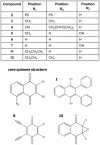

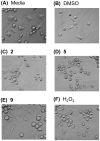
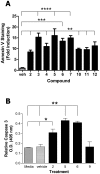
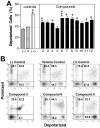
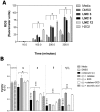
References
-
- Bentinger M, Tekle M, Dallner G (2010) Coenzyme Q – Biosynthesis and functions. . Biochemical and Biophysical Research Communications 396(1) p. 74–79. - PubMed
-
- Kim YM, Lee CH, Kim HG, Lee HS (2004) Anthraquinones Isolated from Cassia tora (Leguminosae) Seed Show an Antifungal Property against Phytopathogenic Fungi. . Journal of Agricultural and Food Chemistry 52(20) p. 6096–6100. - PubMed
-
- Tasdemir D, Brun R, Yardley V, Franzblau SG, Ruedi P (2006) Antituberculotic and Antiprotozoal Activities of Primin, a Natural Benzoquinone: In vitro and in vivo Studies. . Chemistry & Biodiversity 3(11) p. 1230–1237. - PubMed
-
- Ui H, Ishiyama A, Sekiguchi H, Namatame M, Nishihara A, et al. (2007) Selective and Potent In Vitro Antimalarial Activities Found in Four Microbial Metabolites. . The Journal of Antibiotics 60(3) p. 220–222. - PubMed
-
- Brondani DJ, Nascimento CR, de M Moreira DR, Lima Leite AC, de Souza IA, et al. (2007) Synthesis and Antitumour Activity of the Primin (2-methoxy-6-n-pentyl-1, 4-benzoquinone) and Analogues. . Medicinal Chemistry 3(4) p. 369–372. - PubMed
Publication types
MeSH terms
Substances
Grants and funding
LinkOut - more resources
Full Text Sources
Other Literature Sources
Research Materials

